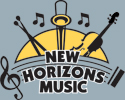
We Offer Music Classes and Workshops!
About Us
The New Horizons Band of Toronto (NHBT) is a multi-level concert band and music education program for adults. In-person classes are now complemented by online classes and virtual band settings that extend in-person rehearsals.
With in-person classes, members can try out a band instrument for the first time or reconnect with an instrument they played years ago. NHBT also welcomes experienced musicians who want to play in a non-competitive setting. NHBT is designed to provide everything you need to help you on your musical journey. As you progress, you will find ongoing educational support to continue this journey from our professional music educators. You will also experience the support and camaraderie of your fellow musicians. You can read more about our teachers on the Leadership page.
Those with more developed skills should discuss whether one of the advanced levels – Concert Band, Symphonic Band or Wind Symphony – would be a good fit for you. Before registering, Contact Us to find out what openings there might be for your instrument.
Classes for the regular in-person season start in September and run until early June over two terms. Each class rehearses once per week. We take a break from mid-December until mid-January. See our Join Us page for more details and a weekly agenda of classes.
All classes are held at 662 Victoria Park Ave (North-West corner of Victoria Park and Danforth Ave) immediately south of the Victoria Park subway and bus TTC station.
Online classes and workshops run concurrently with and complement in-person rehearsals.
Have more questions? Check out our Frequently Asked Questions area FAQ.
